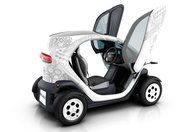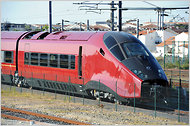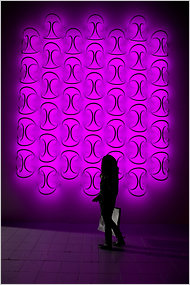LONDON—After screening"Star Wars"for his students,a professor at the Massachusetts Institute of Technology pointed to a"remote"—as droids or robots are called in the movie—with which Luke Skywalker had been practicing his light saber fencing skills,and said:"I want you to build me some of those."
Enlarge This Image Renault Renault Twizy electric city car goes on sale in Europe in late 2011.
Renault Renault Twizy electric city car goes on sale in Europe in late 2011.
 ArtsBeat
ArtsBeat Breaking news about the arts,coverage of live events,critical reviews,multimedia and more.
Breaking news about the arts,coverage of live events,critical reviews,multimedia and more.
Go to Arts Beat A sortable calendar of noteworthy cultural events in the New York region,selected by Times critics.
A sortable calendar of noteworthy cultural events in the New York region,selected by Times critics.
Go to Event Listings Enlarge This Image Xavier Leoty/Agence France-Presse Getty Images A new high-speed train produced by Alstom,on a testing track in Aytre,western France in September.
Xavier Leoty/Agence France-Presse Getty Images A new high-speed train produced by Alstom,on a testing track in Aytre,western France in September.
Enlarge This Image Michael Loos The Wallpiercing LED lighting system,designed by Ron Gilad for Flos.
Michael Loos The Wallpiercing LED lighting system,designed by Ron Gilad for Flos.
The students obliged,and three of their droids are now orbiting the earth on the International Space Station.Known as Synchronized Position,Hold,Engage and Reorient Experimental Satellites(Spheres for short),they are roughly the same size as bowling balls and are being used to test how the astronauts working at the space station can assemble spacecraft,maintain satellites and conduct emergency repairs in zero gravity up there.
The lessons learned from the Spheres and all of the other research conducted on the space station,which is scheduled to continue through the end of this year,will be used to develop new technologies,materials and other advances,which will keep designers busy for decades to come.The Spheres themselves are to be celebrated in"Talk to Me,"an exhibition opening in July at the Museum of Modern Art in New York that will explore the ways in which we communicate with objects.Among the exhibits will be data visualizations,digital interfaces,signage systems and more modest,yet useful innovations such as a Rubik's Cube for people with poor sight in which the sides of the rotating cubes are identified by Braille symbols,rather than colors.
Tackling one of the most topical issues in design makes"Talk to Me"a strong contender to be one of the most memorable design exhibitions of 2011.And its underlying theme,the impact of technology on daily life will be visible in every area of design throughout the year.
Within communications design,there will be further advances in data visualization,the new form of imagery that is fast replacing traditional charts,graphs and maps as a clearer,more accurate medium for depicting complex,rapidly changing data.We will also see a flood of newly designed digital devices in 2011 as Apple's rivals introduce their ripostes to the iPad.Hopefully some of them will be more than uninspired clones of the original.
Another challenge will be to develop compelling applications for those devices,as well as for the iPad and iPhone,particularly in areas like publishing,which have so far been disappointingly unadventurous in designing app versions of printed media,such as books and magazines.Designers also may seek to devise more effective ways of helping us to edit the surge of digital content and to solve the security problems it creates.
Transportation will be an equally dynamic area of design.Some of the major automotive companies are to launch new electric vehicles this year.Ford and BMW plan to start selling small electric sedans,the Focus Electric and ActiveE,respectively.And Renault is to begin production of electric versions of its Fluence sedan and Kangoo van.
Energy efficiency apart,these electric cars will be fairly conventional in terms of concept and styling.A more audacious development will be the introduction of Renault's tiny Twizy city car,which is to go on sale in Europe at the end of 2011.Fitted with two seats,one behind the other,the Twizy will be just 2.32 meters long,1.19 meters wide and 1.46 meters high—that's 7 feet 6 inches,3 feet 9 inches and 4 feet 8 inches.Renault plans to price it like a three-wheeled scooter rather than a car.
As more electric vehicles hit the roads,pressure will mount for national and local governments to install efficient,conveniently located charging systems.This provides intriguing opportunities for designers both to create new charging networks from scratch and to adapt existing electrical infrastructure,such as street lights and telephone kiosks.
Another focus of transport innovation will be railroads,as more countries install high speed lines to introduce energy-efficient,high speed trains.The Automotriceàgrande vitesse—alias the A.G.V.—the very-high-speed train developed by Alstom in France as a successor to the Trainàgrande vitesse,the T.G.V.,is to start commercial service in Italy in the autumn.A self-propelled train with an engine beneath each carriage,the A.G.V.will have a top commercial speed of 360 kilometers an hour,about 225 miles an hour.It is expected to take roughly three hours to travel the 475 kilometers from Rome to Milan.
As well as being unusually fast,the A.G.V.has been designed to be exceptionally energy efficient.Ninety-eight percent of its materials—including aluminum,steel,copper and glass—are recyclable and it uses 15 percent less energy than a conventional train.It also generates electricity from its motors and braking system,which return energy to the train as it slows down.
Energy efficiency also will be the focus of design innovation in the home.There will be further improvements in the digital systems that enable us to control the services in our homes and thereby use energy more efficiently.Lighting will change,too,as incandescent light bulbs begin to disappear—Ikea stopped selling them in the United States on Jan.1—and designers experiment with the latest versions of energy-efficient sources such as LEDs(tiny,intense spots of light)and OLEDs(fine strips of light).
As in every other area of design,the critical question will be whether designers seize the chance to develop entirely new types of lighting,or simply add energy-efficient light sources to old ones.
The Israeli designer Ron Gilad has set an encouraging precedent by developing for the Italian company Flos a stunning series of LED lights that wash the wall in vivid colors.They were among the hits of the Milan Furniture Fair last year and the next wave of LED and OLED innovations should be highlights of the 2011 fair,if—and it's a big if—their designers are as gutsy and imaginative.





